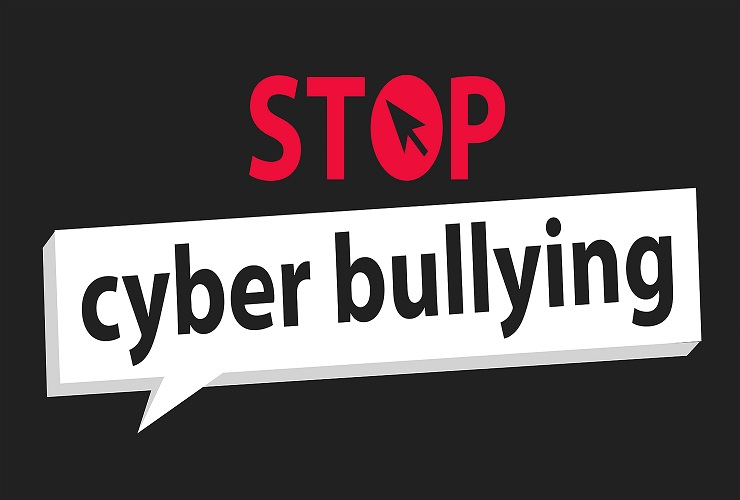Cyberbullying is a form of bullying that takes place via internet connected devices like smartphones, computers, or tablets. Cyberbullying can occur via social media, email, messaging apps, text messages, forums, games, and more. Any online medium that allows for the sharing of information can become a platform for cyberbullying.
Simply put, cyberbullying is the use of technology to intimidate, harass, threaten, torment, or humiliate a target. Examples of cyberbullying including sending mean texts, posting false information about a person online, or sharing embarrassing photos or videos.
Cyberbullying differs from in-person bullying (although the two are not mutually exclusive) in that it can be:
- More difficult to recognize – What children and teenagers do online is not always readily apparent to parents and teachers. Bullying conducted via text or online medium can more easily go unnoticed.
- More relentless – Cyberbullying doesn’t end at school, and can follow a child home.
- More enduring – Cyberbullying leaves a paper trail that can follow both the bully and the victim for years
Different Types of Cyber Bullying
Parents and educators should be aware of the different types of cyberbullying, so they can adopt measures to prevent and confront it. Common forms of cyberbullying include:
- Doxing – publishing revealing personal information about an individual online, for purposes of humiliating, defaming, or harassing the victim
- Harassment – posting hurtful, threatening, or intimidating messages online, or sending them directly to someone, with the intention of harming that person
- Impersonation – creating fake accounts or gaining access to a person’s real social media accounts and posting things to damage the victim’s reputation
- Cyberstalking – tracking and monitoring a person’s online activity, and using the internet to stalk or harass an individual
How to Prevent Cyber Bullying?
As cyberbullying becomes more prevalent, it is increasingly important for parents and educators to take steps to prevent it. Here are some tips for adults to prevent cyberbullying:
1. Be aware of your child’s online activities
Children should not be allowed to browse the internet freely. Parents and teachers should monitor the sites that the children use and be cognizant of the apps they download and digital media they consume. Children should have their screen time limited, and be encouraged to engage more in offline activities
2. Watch for the following signs of cyberbullying in children:
- Refusal to allow you to see what they are doing online
- Avoidance of discussing what they are doing online
- Sudden, unexplained increase or decrease in online activity
- Deactivating social media accounts
- Emotional responses (including sadness, anger, happiness) linked to their device usage
Adults should also teach children to recognize and be aware of the signs of cyberbullying themselves. Children are often less aware of cyberbullying than adults. Make sure your children are aware of what cyberbullying is, and teach them the following tips:
- Refuse to participate in, or aid cyberbullying (including refusing to pass along cyberbullying messages, refusing to
- allow their friends to partake in cyberbullying, and refusing to communicate with cyberbullies)
- Never share passwords for their online accounts
- Never put something online that they wouldn’t want everyone to see
- Block communication with cyberbullies and do not read messages
Impact of cyberbullying on students
Cyberbullying can have a serious impact on student’s self-esteem, grades, and overall quality of life. Because cyberbullying does not end at school and can continue 24 hours a day, it can be very difficult for children to escape. As long as a child has access to a phone, computer, or other internet connected device, he or she is susceptible to cyberbullying. Studies have demonstrated the major impact that cyberbullying has, including:
- Emotional problems, including depression, anxiety, low self-esteem, and stress for victims of cyberbullying
- Increased likelihood of anxiety, depression, low life satisfaction, and drug and alcohol abuse for the cyberbullies
- Lowered scholastic achievement and satisfaction for both the bully and the bullied
- Increased likelihood for victims of cyberbullying to be bullied offline
- Cyberbullies face a greater chance of being cyberbullied in return, and targets of cyberbullying have an increased change of become bullies themselves
- Targets of cyberbullying face an increased risk for suicidal thoughts and attempts
For the cyberbullies, the consequences of their actions can very severe, including being suspended or expelled from school and being removed from sports team, clubs, and activities. Certain types of cyberbullying can even be considered criminal.
How Parents Can Help?
Cyberbullying can be a challenging problem for parents to deal with because they often do not possess the technical skills or knowhow to keep up with everything their children are doing online. Schools are increasingly educating and training their employees in how to recognize and address cyberbullying instances, but it is still critical for parents to know the signs of cyberbullying, and how to respond to them.
The first step to help your child is to inform them of what cyberbullying is, and how to recognize it. Parents should set age-appropriate technology-use guidelines for their children to follow when using electronics. Parents should also teach their children basic strategies to deal with potential cyberbullying situations before they become more serious, such as blocking the bully, protecting personal information, and ignoring or reporting inappropriate messages.
It is also important to create a safe, open environment, in which your child feels comfortable coming to you if they are being cyberbullied. Many children who are targets of cyberbullying, do not report it to their parents for fear of losing internet or cell phone privileges.
If you discover that your child is being cyberbullied, it is important to offer them your reassurance and support. You should make sure that your child knows that being a victim of bullying is not their fault, and that a bullying incident says more about the bully than the target.
Tell your child that they did the right thing by coming to you, and assure them that they will not be punished. Tell them that together you will figure out the right course of action to take.
The first step you should take, assuming the cyberbully is a classmate of your child, is to report the cyberbullying incident to someone at the school. Most schools have policies in place for responding to bullying incidents.
In addition to this, you should take steps to prevent future bullying incidents through a few common-sense measures:
- Block the bully – Make sure the bully can no longer contact your child by blocking them on whatever platform they’ve been bullying your child
- Give your child online safety tips – Make sure your child knows never to share their password, post their location online, or share any sensitive information
- Limit technology time – Although it may seem like a punishment, sometimes it is necessary to limit technology access for children who are being bullied and can’t resist the temptation to check their messages or social media. Moving computers out of children’s rooms or putting limits on cell phone and video game use can help keep your child away from cyberbullies
Trends to address cyberbullying
Effective approaches to dealing with cyberbullying must involve education, prevention, detection, and remediation; and requires involvement from parents, teachers, school administrators, children, and law enforcement.
Although technology is the catalyst that allows cyberbullying to take place, new trends in cyberbullying detection and prevention for schools involves the use of technology, such as IT management platforms to set alerts for administrators when students use a school device for cyberbullying. NuEduSEC’s alert allow school admins to get instant notifications if a student uses a school laptop, desktop, tablet, or other device for cyberbullying. Using technology to combat cyberbullying can help close the gap between what students do online and what parents and administrators are aware of.



 (31 votes, average: 3.71 out of 5)
(31 votes, average: 3.71 out of 5)


